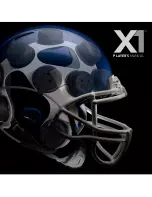
Blizzard Enclosure User Manual
page 19
‘piles on’ to DEC3.2 operation, within defined safety limits. However, until such
time as the temperature reaches the TOP limit, the heater may be enabled and the
fan disabled, which is why the mode should only be used for Test and Service use
by a trained technician.
DEC3.2 Control Parameters
DEC3.2 will run out of the box with its default parameter settings, which equate to the (fixed)
settings of its predecessor DECs 1 and 2.
Temperature:
Top Set
Range 35-45°C, Default = 40°C
Most manufacturers recommend a max temperature for their
equipment of 40°C, though this does vary. When DEC3.2 senses a
temperature higher than Top Set, it indicates an overtemp
condition as a warning. NOTE: in moving light enclosures the
thermal sensor is necessarily placed in the exhaust air path,
which will be higher (sometimes a lot higher) than the actual
fixture ambient. This needs to be kept in mind when adjusting
temperature settings.
Cutoff Temp
Range 0-15°C, Default = 15°C
This is a setting
above
the Top Set temperature that determines
the temperature at which the lamp relay is opened cutting off
power from the fixture/projector. User may reduce it as desired,
but should establish before doing so the actual operating
temperatures experienced in hot weather before doing so, to
avoid nuisance tripping.
Bottom Set
Range 0-10°C, Default = 10°C
The temperature maintained by the heater in cold conditions.
Most equipment manufacturers recommend a minimum
operating temperature of 0°C, and users may set it lower than the
default if desired.
Humidity
Range 50-90%,
Default 80%
The threshold at which incoming air is more aggressively heated to remove
moisture.
DMX Address
Range 001-510, Default 001
Sets the DMX address for the lamp relay control. In the DMX/RDM service mode,
the subsequent two DMX slots control fan and heater respectively.
Fan Overrun
Range 1-15 minutes, Default 5 minutes
This is the time that the enclosure fan(s) will run after the fixture/projector lamp
is turned off. As a general rule, the more powerful the lamp, the longer the
overrun should be, to prevent overheating while the lamp cools down.
















































